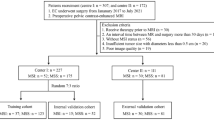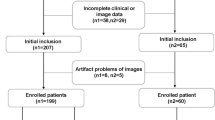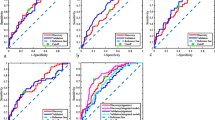Abstract
Objectives
To establish and validate a radiomics model based on multiparametric magnetic resonance imaging (MRI), and to predict microsatellite instability (MSI) status in rectal cancer patients.
Methods
A total of 199 patients with pathologically confirmed rectal cancer were included. The MSI status was confirmed by immunohistochemistry (IHC) staining. Clinical factors and laboratory data associated with MSI status were analyzed. The imaging data of 100 patients from one of the hospitals were used as the training set. The remaining 99 patients from the other two hospitals were used as the external validation set. The regions of interest (ROIs) were delineated from T1-weighted imaging (T1WI), T2-weighted imaging (T2WI), diffusion-weighted imaging (DWI), and contrast-enhanced T1WI (CE-T1WI) sequence to extract the radiomics features. The Tree-based approach was used for feature selection. The models were constructed based on the four single sequences and a combination of the four sequences using the random forest (RF) algorithm. The external validation set was used to verify the generalization ability of each model. The receiver operating characteristic (ROC) curves and the area under the curve (AUC) were plotted to evaluate and compare the predictive performance of each model.
Results
In the four single-series models, the CE-T1WI model performed the best. The AUCs of the T1WI, T2WI, DWI, and CE-T1WI prediction models in the training set were 0.74, 0.71, 0.71, and 0.78, respectively, while in the external validation set, the corresponding AUCs were 0.67, 0.66, 0.70, and 0.77. The prediction and generalization performance of the combined model of multi-sequences was comparable to that of the CE-T1WI model and it was better than that of the remaining three single-series models, with AUC values of 0.78 and 0.78 in the training and validation sets, respectively.
Conclusion
The established radiomics models based on CE-T1WI or multiparametric MRI have similar predictive performance. They have the potential to predict MSI status in rectal cancer patients.
Key Points
• A radiomics model for the prediction of MSI status in patients with rectal cancer was established and validated using external validation.
• The models based on CE-T1WI or multiparametric MRI have better predictive performance than those based on single unenhanced sequence images.
• The radiomics model has the potential to suggest MSI status in rectal cancer patients; however, it is not yet a substitute for histological confirmation.




Similar content being viewed by others
Abbreviations
- AUC:
-
Area under the curve
- CA199:
-
Carbohydrate antigen-199
- CEA:
-
Carcinoembryonic antigen
- CE-T1WI :
-
Contrast-enhanced T1WI
- CRC :
-
Colorectal cancer
- DWI:
-
Diffusion-weighted imaging
- IHC:
-
Immunohistochemistry
- MRI:
-
Magnetic resonance imaging
- MSI:
-
Microsatellite instability
- MSI-H:
-
MSI high
- MS-L/S:
-
MS-low/stable
- NCCN:
-
National Comprehensive Cancer Network
- RF:
-
Random forest
- ROC:
-
Receiver operating characteristic
- ROI:
-
Regions of interest
- T1WI:
-
T1-weighted imaging
- T2WI:
-
T2-weighted imaging
References
Siegel RL, Miller KD, Fuchs HE et al (2021) Cancer statistics, 2021. CA Cancer J Clin 71(1):7–33
O'Connell E, Reynolds IS, McNamara DA et al (2020) Microsatellite instability and response to neoadjuvant chemoradiotherapy in rectal cancer: a systematic review and meta-analysis. Surg Oncol 34:57–62
Hasan S, Renz P, Wegner RE et al (2020) Microsatellite Instability (MSI) as an Independent Predictor of Pathologic Complete Response (PCR) in locally advanced rectal cancer: a National Cancer Database (NCDB) analysis. Ann Surg 271(4):716–723
Benson AB, Venook AP, Al-Hawary MM et al (2018) Rectal cancer, version 2.2018, NCCN clinical practice guidelines in oncology. J Natl Compr Canc Netw 16(7):874–901
Song Y, Wang L, Ran W et al (2020) Effect of tumor location on clinicopathological and molecular markers in colorectal cancer in Eastern China patients: an analysis of 2,356 cases. Front Genet 11:96
Cheng Y, Luo Y, Hu Y et al (2021) Multiparametric MRI-based Radiomics approaches on predicting response to neoadjuvant chemoradiotherapy (nCRT) in patients with rectal cancer. Abdom Radiol (NY) 46(11):5072–5085
Wan L, Peng W, Zou S et al (2020) MRI-based delta-radiomics are predictive of pathological complete response after neoadjuvant chemoradiotherapy in locally advanced rectal cancer. Acad Radiol Suppl 1:S95–S104
Shu Z, Mao D, Song Q et al (2021) Multiparameter MRI-based radiomics for preoperative prediction of extramural venous invasion in rectal cancer. Eur Radiol 32(2):1002–1013
Shu Z, Fang S, Ding Z et al (2019) MRI-based Radiomics nomogram to detect primary rectal cancer with synchronous liver metastases. Sci Rep 9(1):3374
Liu H, Zhang C, Wang L et al (2019) MRI radiomics analysis for predicting preoperative synchronous distant metastasis in patients with rectal cancer. Eur Radiol 29(8):4418–4426
Chen F, Ma X, Li S et al (2020) MRI-based radiomics of rectal cancer: assessment of the local recurrence at the site of anastomosis. Acad Radiol Suppl 1:S87–S94
Zhang W, Huang Z, Zhao J et al (2021) Development and validation of magnetic resonance imaging-based radiomics models for preoperative prediction of microsatellite instability in rectal cancer. Ann Transl Med 9(2):134
Zhang W, Yin H, Huang Z et al (2021) Development and validation of MRI-based deep learning models for prediction of microsatellite instability in rectal cancer. Cancer Med 10(12):4164–4173
Zwanenburg A, Vallieres M, Abdalah MA et al (2020) The image biomarker standardization initiative: standardized quantitative radiomics for high-throughput image-based phenotyping. Radiology 295(2):328–338
Pathak SJ, Mueller JL, Okamoto K et al (2019) EPCAM mutation update: Variants associated with congenital tufting enteropathy and Lynch syndrome. Hum Mutat 40(2):142–161
Popat S, Hubner R, Houlston RS (2005) Systematic review of microsatellite instability and colorectal cancer prognosis. J Clin Oncol 23(3):609–618
Ribic CM, Sargent DJ, Moore MJ et al (2003) Tumor microsatellite-instability status as a predictor of benefit from fluorouracil-based adjuvant chemotherapy for colon cancer. N Engl J Med 349(3):247–257
Yang SY, Cho MS, Kim NK (2018) Difference between right-sided and left-sided colorectal cancers: from embryology to molecular subtype. Expert Rev Anticancer Ther 18(4):351–358
Samowitz WS, Curtin K, Wolff RK et al (2009) Microsatellite instability and survival in rectal cancer. Cancer Causes Control 20(9):1763–1768
Samowitz WS, Curtin K, Ma KN et al (2001) Microsatellite instability in sporadic colon cancer is associated with an improved prognosis at the population level. Cancer Epidemiol Biomarkers Prev 10(9):917–923
Li Z, Zhong Q, Zhang L et al (2021) Computed tomography-based radiomics model to preoperatively predict microsatellite instability status in colorectal cancer: a multicenter study. Front Oncol 11:666786
Cao Y, Zhang G, Zhang J et al (2021) Predicting microsatellite instability status in colorectal cancer based on triphasic enhanced computed tomography radiomics signatures: a multicenter study. Front Oncol 11:687771
Beets-Tan RGH, Lambregts DMJ, Maas M et al (2018) Magnetic resonance imaging for clinical management of rectal cancer: updated recommendations from the 2016 European Society of Gastrointestinal and Abdominal Radiology (ESGAR) consensus meeting. Eur Radiol 28(4):1465–1475
Bulens P, Couwenberg A, Haustermans K et al (2018) Development and validation of an MRI-based model to predict response to chemoradiotherapy for rectal cancer. Radiother Oncol 126(3):437–442
Petkovska I, Tixier F, Ortiz EJ et al (2020) Clinical utility of radiomics at baseline rectal MRI to predict complete response of rectal cancer after chemoradiation therapy. Abdom Radiol (NY) 45(11):3608–3617
Kudou M, Nakanishi M, Kuriu Y et al (2020) Value of intra-tumor heterogeneity evaluated by diffusion-weighted MRI for predicting pathological stages and therapeutic responses to chemoradiotherapy in lower rectal cancer. J Cancer 11(1):168–176
Cai C, Hu T, Gong J et al (2021) Multiparametric MRI-based radiomics signature for preoperative estimation of tumor-stroma ratio in rectal cancer. Eur Radiol 31(5):3326–3335
Maby P, Tougeron D, Hamieh M et al (2015) Correlation between density of CD8+ T-cell infiltrate in microsatellite unstable colorectal cancers and frameshift mutations: a rationale for personalized immunotherapy. Cancer Res 75(17):3446–3455
De Smedt L, Lemahieu J, Palmans S et al (2015) Microsatellite instable vs stable colon carcinomas: analysis of tumour heterogeneity, inflammation and angiogenesis. Br J Cancer 113(3):500–509
Li Z, Dai H, Liu Y et al (2021) Radiomics analysis of multi-sequence MR images for predicting microsatellite instability status preoperatively in rectal cancer. Front Oncol 11:697497
Zhao B, Tan Y, Tsai WY et al (2016) Reproducibility of radiomics for deciphering tumor phenotype with imaging. Sci Rep 6:23428
Funding
The authors state that this work has not received any funding.
Author information
Authors and Affiliations
Corresponding author
Ethics declarations
Guarantor
The scientific guarantor of this publication is Feng Chen.
Conflict of interest
The authors of this manuscript declare no relationships with any companies, whose products or services may be related to the subject matter of the article.
Statistics and biometry
One of the authors has significant statistical expertise.
Informed consent
Written informed consent was waived by the Institutional Review Board.
Ethical approval
Institutional Review Board approval was obtained.
Methodology
• Retrospective
• Diagnostic or prognostic study
• Multicenter study
Additional information
Publisher’s note
Springer Nature remains neutral with regard to jurisdictional claims in published maps and institutional affiliations.
Supplementary Information
ESM 1
(PDF 110 kb)
Rights and permissions
Springer Nature or its licensor holds exclusive rights to this article under a publishing agreement with the author(s) or other rightsholder(s); author self-archiving of the accepted manuscript version of this article is solely governed by the terms of such publishing agreement and applicable law.
About this article
Cite this article
Li, Z., Zhang, J., Zhong, Q. et al. Development and external validation of a multiparametric MRI-based radiomics model for preoperative prediction of microsatellite instability status in rectal cancer: a retrospective multicenter study. Eur Radiol 33, 1835–1843 (2023). https://doi.org/10.1007/s00330-022-09160-0
Received:
Revised:
Accepted:
Published:
Issue Date:
DOI: https://doi.org/10.1007/s00330-022-09160-0




